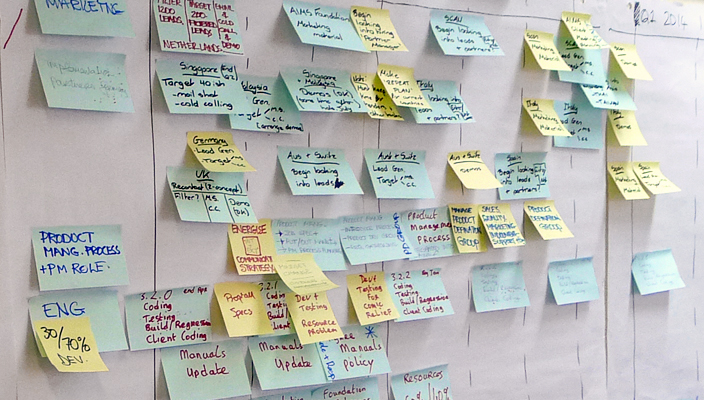I get asked all the time “What does a product manager do?” Got me thinking, why not a blog post! Just about every company has their own definition of expectations….

What does a product manager do?
I get asked all the time “What does a product manager do?” Got me thinking, why not a blog post!
Just about every company has their own definition of expectations. Sometimes, when you see a job description, you will see some things like:
- Work closely with Engineering, Design, and Content teams to create and ensure successful execution of the product roadmap.
- Manage the product backlog and work with team to prioritize their activities
- Communicate aligned business priorities to leadership
These are very important and definitely are part of the job. In my opinion, being a product manager has some understood responsibilities that really differentiate the good product managers from those that just go through the motions. I will go through some things that I believe are important to know and understand.
The 2 flavors of product management roles
Product management can be split into standard product management and technical product management. When you evaluate positions, be sure to understand which type of role it is.
Standard product management is the traditional role. A product manager in this role will be highly involved in the business activity of a product. You can expect to run some form of agile process with the team, writing solid user stories, communicating go-to-market strategies (if consumer facing), being the go to for the product, determining the priorities of new features/functionality and understanding stakeholder needs. As a product manager, you will analyze data and usage, speak consistently with consumers and make decisions that promote growth, engagement and align with the larger company goals.
Technical product management roles are more deeply engaged with platform and development. Focusing heavily on technically moving products ahead, usually during migrations, large maintenance of technical debt or internal platform APIs. They may or may not have business initiatives but they may differ in expectations.
Agile
Companies are jumping on the agile bandwagon and I have to admit, it makes such a huge difference when some form of agile or scrum process is used. Agile is focused on delivering quality at speed and making development flexible through iterative evaluation. Through timed sprints, teams are able to focus on delivering quality sets of features.
The misconception, from what I have seen, is that product has all the answers.
Above all else, it is about communication and developing conversations. The misconception, from what I have seen, is that product has all the answers. Product, more importantly, has the questions. A great product manager has a conversation with the team to create solutions. The agile process is a conduit that empowers more conversation through grooming, planning, demos and retrospectives.
Strategy
Strategic thinking is a critical component to product success. You have to be able to see all the moving parts and understand the big picture. My strategy is simple. I lay everything out and then focus teams on singular goals that lead to deliver value for an initiative. I’ve seen some product managers who want to distribute teams across multiple tasks to “get more done”. It doesn’t equate to efficiency. As an agile PM, I have learned that if you are trying to do everything, you are doing nothing.
Efficiency is the combination of speed and productivity. One is not relevant without the other.
The goal is to execute, test and execute again. Learning from each result and providing value. Understanding this process will help you to create strategies that are flexible and keep you on track for success.
Analytics
Understanding product analytics is a key to success. Product managers should be able to speak to how their products and features are used and by who. Sometimes a product manager will have analysts that assist in data exploration but a good product manager can query SQL or learn how to use the analytics resources at their disposal. I really like tableau as a visualization tool but being a previous UI engineer in the analytics space, I sometimes code my own JavaScript visualizations using D3 (charting and graphing) or Leaflet (maps).
Know the lingo, how to read it and how it relates to product success. KPI, ROI, these are all types of metric definitions you should be familiar with. Set your goals based on where you are and where you want to be. Understand that the only real failure is from fear or not knowing where you want to be.
Read: http://johnsteinmetz.net/blog/strategic-analytics-validation-accessibility-innovation-repeat
Relationships
An important characteristic of any good product manager is the ability to establish and nurture relationships with the people you interact with. Executives, developers, product peers, partners, vendors and consumers, each one of these relationships carries with it a different responsibility and method of interaction. Communication, evaluation, collaboration, negotiation, empathy, it is all part of the everyday job of the product manager. Your job is to know where the product is going and make sure that all stakeholders understand that vision and it’s impact on the business. It isn’t always easy but good product managers enjoy and evolve the discussion.
Read: http://johnsteinmetz.net/blog/account-managers-tips-to-successfully-work-with-developers (relationship building)
User Stories
Each part of the team has a purpose and in the symbiotic relationship between product and development, the product manager defines the priority of work. A product manager is NOT there to define what to do. A product manager is there to establish a dialogue with development to define the best solutions for a given market or to create new markets.
A user story is written by defining the audience, the problem and the expected outcome.
“As a user I need to be able to login to the application so that I can manage the details of my account.”
User stories are extremely important because the concise nature and limited development detail express the true nature of a need. Your job is to not state the how, but to begin a conversation with engineering. The user story is that conversation starter. One can say that a product manager brings out the innovation in an engineer through those conversations.
Experience
Every time you fail, make a bad decision or run a test with an unexpected outcome, you gain experience. You don’t get to be a good product manager by always having success. Good product managers learn through failure and iterate. Over time, failures occur from risk and not through baseline situations. Good product managers build success through a risk and reward system of decisions that balance business need with market demand. It isn’t easy but it is very rewarding.
Measuring Success
How do I measure overall success? Easy. Release code often.
If you have solid user stories that provide business value, the more code that is put into the product defines success. Of course, different product managers should define their own standards. I just know that I want to provide value. To me, there is no bigger success than frequent, quality code that provides incremental value to consumers.
Daily success comes from setting daily goals. Every day I make lists of things I want to accomplish. Clearing the backlog of things we will never do, responding to stakeholder questions, etc.
For weekly goals I like to make sure that I am prepared for the next sprint and I like to have a few conversations with dev and customers. Goals are essential to success. A also set aside a few hours a week for pure research or looking into out of the box ideas.
Everything
If something isn’t done, do it. Plain and simple. You have to be resourceful and fill in the gaps. Escalate, design, unblock, analyze, code (if you can), market, write copy, a product manager’s job is to move things along and provide incremental value. I’ve yet to truly experience a product role where I was the “CEO” of the product but it is a misnomer. The market is the true owner. What the market says, you do, if it aligns with the business. Remember, the market is never a single person. In the pragmatic marketing training, you are taught that “Your opinion, though valid, is ultimately irrelevant.” Always remember that.
—–
Of course there is so much more but these are the guidelines I work on. All product managers are different and should bring something special to the job. Collaborate with your peers, take the good things they do and incorporate them into your daily work.
If you have questions or comments, reach out to me on social media or linkedin. Id love to discuss my philosophy of product management and how it is a never ending quest for moving forward. Also, read some of my other blog posts on product and development.
If you get a chance, read or listen to the book “The Goal”
It is a great resource that helped me to understand the true nature of product development.



